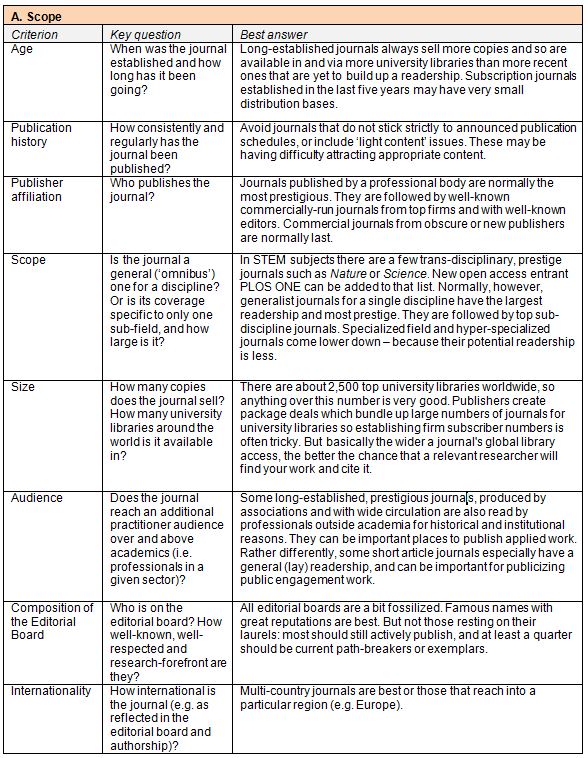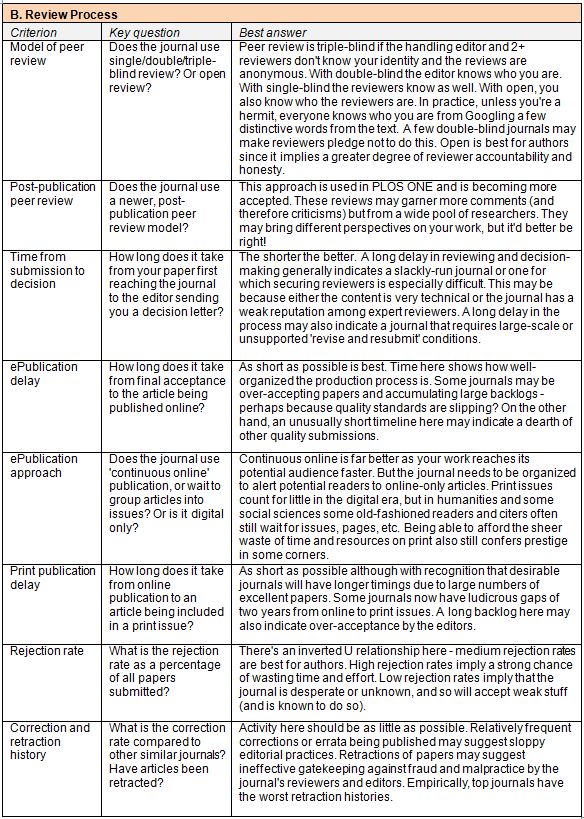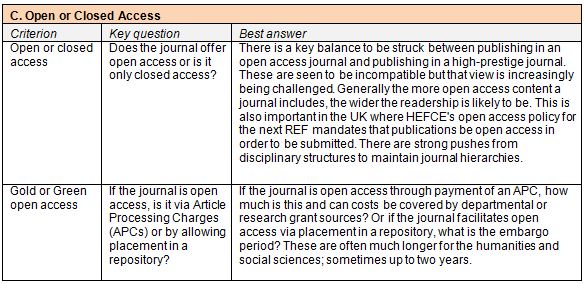What to consider when choosing which journal to submit your paper to
 There
Thereis plenty to consider when making a decision about which journal to
submit your paper to; ranging from basic questions over the journal’s
scope, through its review process and open access offerings, all the
way to the likelihood your work will be widely read and cited. Patrick Dunleavy has compiled a comprehensive list of these considerations, complete with tips on what you should be looking out for.
Wouldn’t
it be great if there was some well-grounded evidence of the best place
to publish your research? After all, you’ve sweated for two or more
years on collecting the data or source materials, thinking through the
issues involved, resolving problems, and writing up the finished text.
You’re heavily invested in the work, and you want to get the best
possible exposure for it in the optimal journal. So ask around in your
department or lab and you’ll quickly find out that there’s a lot of
folklore and anecdotes about where to go, but perhaps that different
people give very different advice.
it be great if there was some well-grounded evidence of the best place
to publish your research? After all, you’ve sweated for two or more
years on collecting the data or source materials, thinking through the
issues involved, resolving problems, and writing up the finished text.
You’re heavily invested in the work, and you want to get the best
possible exposure for it in the optimal journal. So ask around in your
department or lab and you’ll quickly find out that there’s a lot of
folklore and anecdotes about where to go, but perhaps that different
people give very different advice.
Often
your department or lab may have a list of ‘recommended journals’, which
may not be all that useful for various reasons. Often it is what was
left over from some previous audit exercise — in the UK the REF 2014 and
in Australia the ERA 2015 rounds. Often the list is where your local
top professors publish their well-funded research (or perhaps where they
used to publish in their glory days). But perhaps it hasn’t been
updated for a while and has some obvious glitches. It can also often be
just a kind of ‘idiot board’ including any journal over a certain
Journal Impact Factor level, even though this JIF indicator is completely discredited—
e.g. it was outlawed from use in both the REF and ERA studies because
of its gross limitation (see below for more). If you are a PhD student
or an early career researcher, these lists are often just actively
disabling — they may be out of your league for the kind of work that you
have to publish and so just very depressing to read.
your department or lab may have a list of ‘recommended journals’, which
may not be all that useful for various reasons. Often it is what was
left over from some previous audit exercise — in the UK the REF 2014 and
in Australia the ERA 2015 rounds. Often the list is where your local
top professors publish their well-funded research (or perhaps where they
used to publish in their glory days). But perhaps it hasn’t been
updated for a while and has some obvious glitches. It can also often be
just a kind of ‘idiot board’ including any journal over a certain
Journal Impact Factor level, even though this JIF indicator is completely discredited—
e.g. it was outlawed from use in both the REF and ERA studies because
of its gross limitation (see below for more). If you are a PhD student
or an early career researcher, these lists are often just actively
disabling — they may be out of your league for the kind of work that you
have to publish and so just very depressing to read.
 Image credit: School man reading by Wonder woman0731. This work is licensed under a CC BY 2.0 license.
Image credit: School man reading by Wonder woman0731. This work is licensed under a CC BY 2.0 license.
In
fact, when deciding which journal to send material to most senior staff
consider a wide range of factors, not just the obvious things, because
they can all in different ways have considerable effects upon impact.
There is also now a great service available in Google Scholar Metrics
which gives excellent quantitative information about every journal in
the world (of any significance), for free from any PC, tablet or
smartphone. Just type in the journal name to GSM’s search box and get an
instant reply, using two strong indicators discussed below. (Note: be
careful to enter the exact
journal name into GSM— e.g. if the journal uses ‘&’ as part of its
title and you enter ‘and’ instead, GSM will just show nothing as found).
fact, when deciding which journal to send material to most senior staff
consider a wide range of factors, not just the obvious things, because
they can all in different ways have considerable effects upon impact.
There is also now a great service available in Google Scholar Metrics
which gives excellent quantitative information about every journal in
the world (of any significance), for free from any PC, tablet or
smartphone. Just type in the journal name to GSM’s search box and get an
instant reply, using two strong indicators discussed below. (Note: be
careful to enter the exact
journal name into GSM— e.g. if the journal uses ‘&’ as part of its
title and you enter ‘and’ instead, GSM will just show nothing as found).
Beyond
that what more can we say? Well, there is an interesting and extremely
expensive monograph published in 2012 by Stefanie Hauser called, Multi-dimensional Journal Evaluation.
I have tried to extract from this (as best I can) the factors that seem
to have proven relevance to the choices most researchers will be
considering. I have combined information from the factors she tested for
with a wide range of factors mentioned to research colleagues or me as
relevant to a recent research project on The Impact of the Social Sciences, which also included some STEM academics (for some free-to-view materials on this please visit the web page).
that what more can we say? Well, there is an interesting and extremely
expensive monograph published in 2012 by Stefanie Hauser called, Multi-dimensional Journal Evaluation.
I have tried to extract from this (as best I can) the factors that seem
to have proven relevance to the choices most researchers will be
considering. I have combined information from the factors she tested for
with a wide range of factors mentioned to research colleagues or me as
relevant to a recent research project on The Impact of the Social Sciences, which also included some STEM academics (for some free-to-view materials on this please visit the web page).
So I
hope that the factors set out below are relevant for a wide range of
academic and scientific authors. I’ve grouped them into five
categories — about the scope of a journal; its review processes; open or
closed access; coverage, scale and style issues; and lastly, the
journal’s dissemination and impact.
hope that the factors set out below are relevant for a wide range of
academic and scientific authors. I’ve grouped them into five
categories — about the scope of a journal; its review processes; open or
closed access; coverage, scale and style issues; and lastly, the
journal’s dissemination and impact.
I begin with some key aspects of the journal’s mission:

The second dimension concerns how the journal goes about reviewing your work:

A third key dimension concerns open access (still rare and often expensive) or closed access publishing:

The fourth dimension involves the fit between your work and some more specific aspects to consider in submitting:

The
final set of factors to consider is what happens if a journal accepts
your article. How likely is it that publishing there will reach a wide
readership and begin to generate citations to your work?
final set of factors to consider is what happens if a journal accepts
your article. How likely is it that publishing there will reach a wide
readership and begin to generate citations to your work?

To read Stephen Curry’s comprehensive and entertaining critique of JIF, quoted above, please visit his personal website.
This is an edited version of a piece that originally appeared on the author’s personal blog and is reposted with permission.
Note: This article gives the views of
the author, and not the position of the LSE Impact Blog, nor of the
London School of Economics. Please review our comments policy if you have any concerns on posting a comment below.
the author, and not the position of the LSE Impact Blog, nor of the
London School of Economics. Please review our comments policy if you have any concerns on posting a comment below.
About the author
Patrick Dunleavy is
Professor of Political Science and Public Policy at the London School of
Economics and Political Science, where he has worked since 1979. He has
authored and edited numerous books on political science theory, British
politics and urban politics, as well as more than 50 articles in
professional journals. He is Chair of the Public Policy Group.
Impact of Social Sciences – What to consider when choosing which journal to submit your paper to
Professor of Political Science and Public Policy at the London School of
Economics and Political Science, where he has worked since 1979. He has
authored and edited numerous books on political science theory, British
politics and urban politics, as well as more than 50 articles in
professional journals. He is Chair of the Public Policy Group.
No comments:
Post a Comment